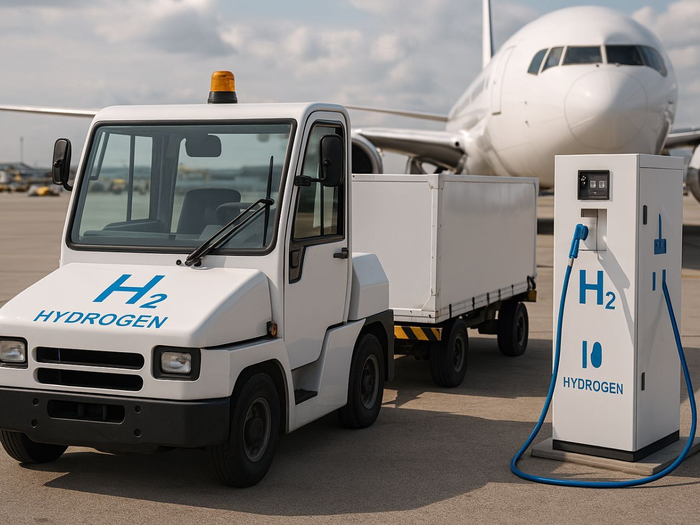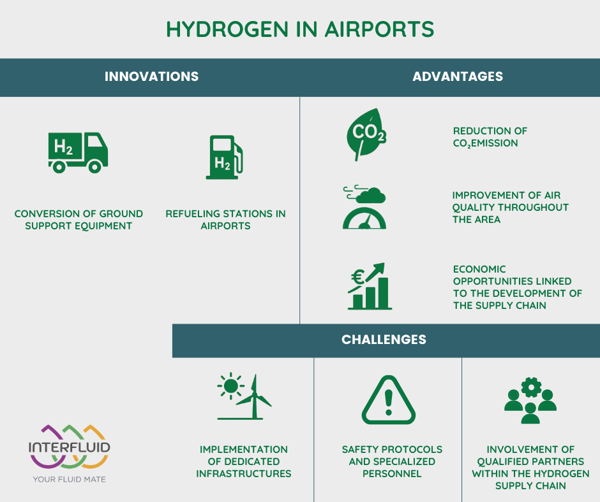
Hydrogen in airports: the future of airport logistics
According to the National Hydrogen Strategy of the Ministry of the Environment and Energy Security, hydrogen is identified as a crucial energy carrier for the transition to a low-carbon economy, with particular attention to sectors difficult to decarbonize, such as aviation.
The introduction of hydrogen in the airport sector represents a crucial turning point for the future of sustainable mobility because, according to the recent guidelines of ENAC and ENEA, the use of green hydrogen will not only significantly contribute to the reduction of emissions (also improving air quality in the areas surrounding airports), but will also radically transform the logistics and operations of airports.
Why is hydrogen essential for airports?
Airports generate significant greenhouse gas emissions from ground activities, such as handling of vehicles, air conditioning, and powering various vehicles and equipment. In this context, hydrogen - and in particular green hydrogen produced from renewable sources - stands as a sustainable alternative to fossil fuels and as a key solution for the decarbonization of the airport sector, being potentially able to eliminate CO₂ emissions related to these activities.
Transformations in airport logistics with hydrogen
With the adoption of hydrogen, airport logistics will undergo profound transformations. Ground Support Equipment (GSE), for example, could be converted into hydrogen-powered vehicles, thus improving operational efficiency and significantly reducing emissions without compromising the autonomy and speed of daily operations, guaranteed by hydrogen refueling stations conveniently located within airports. The success of this transition is clearly closely linked to a detailed mapping of existing vehicles and the assessment of energy needs.
Infrastructure development and operational challenges
The implementation of hydrogen in airports is a highly challenging project that requires the construction of dedicated infrastructure (including production, storage, and distribution facilities) and consequently must take into account many key elements: from the selection of sites for these infrastructures, which must consider factors such as proximity to renewable energy sources and the availability of space, to safety, which as an absolute priority requires rigorous protocols and specialized training for the personnel involved. It is a complex and articulated scenario, in which the contribution of all specialized and qualified entities operating within the hydrogen supply chain will be fundamental.
Environmental and economic benefits of hydrogen in airports
The integration of hydrogen into airport operations, however complex, offers numerous advantages, among which stand out:
- the reduction of greenhouse gas emissions: the use of green hydrogen can significantly contribute to the reduction of CO₂ emissions, supporting the decarbonization goals of the sector;
- the general improvement of air quality: the replacement of fossil fuels with hydrogen in ground operations reduces air pollution in airport areas, bringing benefits to both workers and local communities;
- economic opportunities: the development of a hydrogen supply chain creates new job opportunities and can lead to operational savings in the long term. According to the National Hydrogen Strategy, significant investments are estimated in the transport sector (road, rail, maritime, and indeed air) for the adoption of hydrogen, with potential economic benefits for the entire country system.

Case studies and international best practices
Internationally, several airports are part of similar projects that are exploring the use of hydrogen in the sector:
- OLGA project: launched in October 2021, this European project aims to improve the environmental impact of the aviation sector through the creation of a "Hydrogen Hub" for ground operations and aircraft. Airports such as Paris-Charles de Gaulle and Milan Malpensa are involved in this initiative, which has a budget of 34 million euros.
- Los Angeles Airport (LAX): a study evaluated the feasibility of converting the airport to the use of hydrogen as an energy carrier, highlighting how, under certain conditions, hydrogen-powered passenger aircraft may have lower total costs compared to those powered by traditional fuel.
- Amsterdam Airport: Schiphol Airport has undertaken a pioneering project testing the use of a hydrogen-powered Ground Power Unit (GPU). This GPU provides electrical power to aircraft during stops, powering systems such as lighting and cabin operations. Unlike traditional electric GPUs, which require charging times at specific points, the hydrogen GPU can be refueled directly on site via a tanker truck, optimizing operational efficiency.
- London Airport (Heathrow): Heathrow Airport is making significant progress towards the goal of net-zero emissions, implementing several sustainable initiatives. Recently, Heathrow recorded an increase in passenger traffic, with over 5.7 million travelers served in February 2025, including a 7% growth in flights to the USA and Canada. This increase underscores the importance of balancing air traffic growth with the adoption of sustainable practices.
Future prospects for Italian airports
In Italy, the airports of Rome Fiumicino and Milan Malpensa have been selected as case studies within the SAVES (Sustainable Aviation Vectors for Energy Transition) project, promoted by ENAC and ENEA. This project has evaluated the technical and economic conditions necessary for the introduction of hydrogen in Italian airports, identifying strategic actions to ensure its feasibility and long-term sustainability.
The success of this transition will depend on the collaboration between institutions, airport operators, the energy industry, and companies specialized in the hydrogen supply chain. The adoption of hydrogen is not only an ecological choice, but a fundamental strategy to ensure long-term competitiveness and sustainability in the Italian airport sector.



